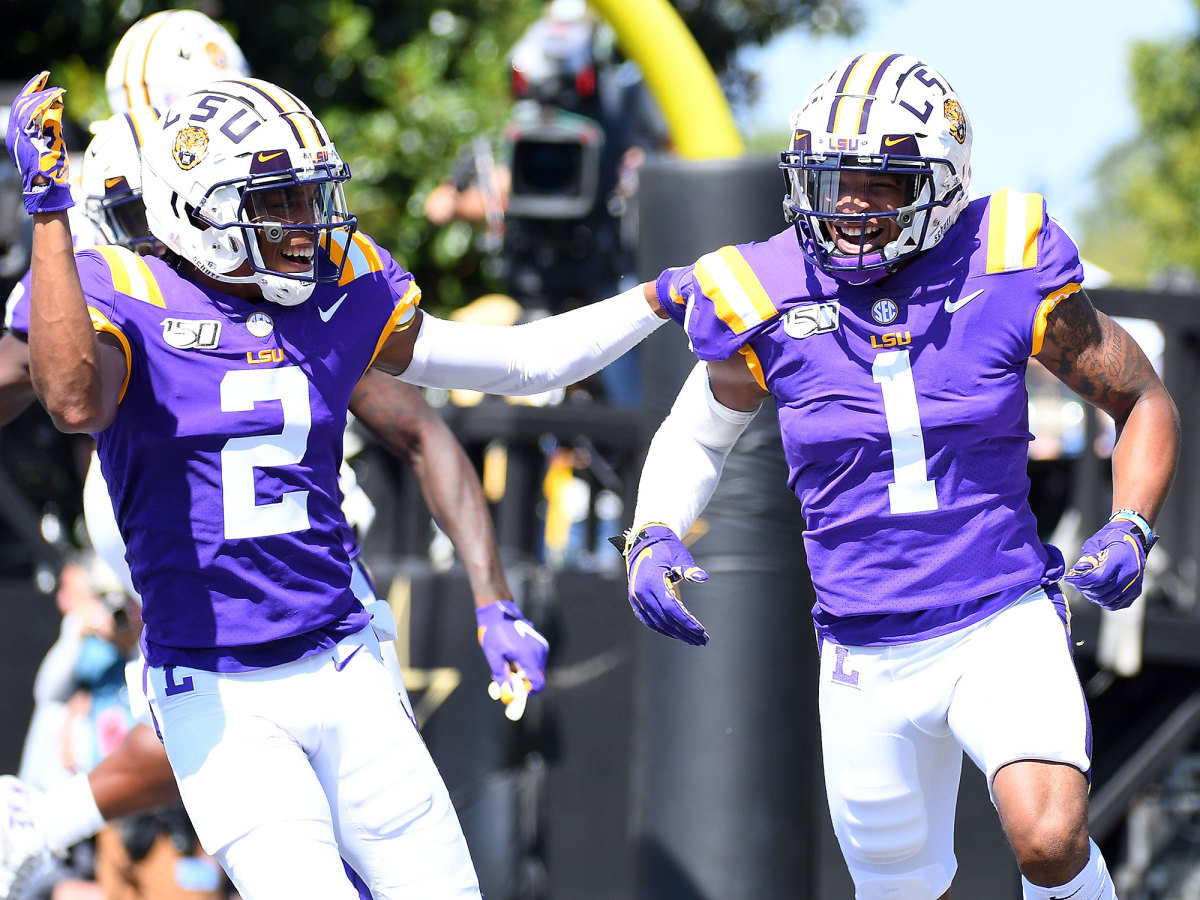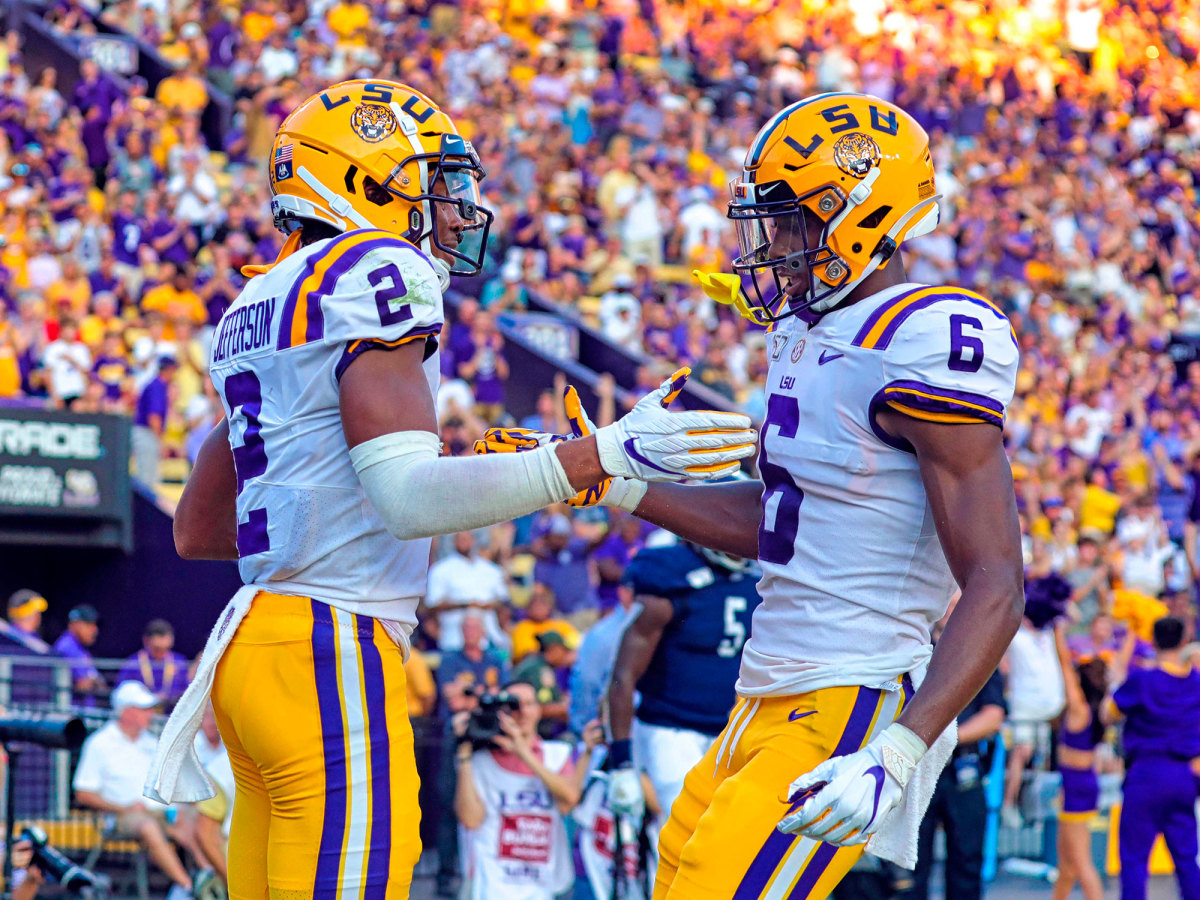Get to Know the Close-Knit LSU Receiver Trio That Rivals Alabama's

BATON ROUGE, La. — Inside LSU’s sparkling new football facility, you’ll find the happiest set of receivers maybe in the program’s rich history. Justin Jefferson, Ja’Marr Chase and Terrace Marshall have collected 1,901 receiving yards, have caught 120 passes and have scored 25 touchdowns. On an average game, the trio combines for 240 yards, 15 catches and three scores.
They’re excelling so much that each of them covets the other’s position. The grass is always greener, right? Chase plays the outside receiver spot X, but he’d like to get a taste inside at F, the slot position. The F, Jefferson, wants to try Z, and Marshall, the Z, has his eye on X. If you’re confused, that’s O.K. We’re all confused, and maybe they are too. “I want to play his position and he wants to play my position and he,” Marshall says gesturing at Chase, “just don’t know what he wants.”
“I just want one route from F,” Chase says. “That’s it.”
“Well,” says Jefferson, “you’re not getting it.”
Round and round they go. You should hear them argue about other matters, like the difference between north and south Louisiana. Marshall, a Bossier City native, is the oddball of the three, hailing from the north part of a state that is separated culturally into two halves. “They always tell me I’m country,” Marshall says, “but I’m not country.” The other two chime in.
“But you sound country.”
“Yeah, you sound country.”
This argument leads to an inevitable end in which Jefferson and Chase question Marshall’s pronunciation of New Orleans while Marshall questions their pronunciation of Bossier. This poking-and-prodding group of friends isn’t so different from the rest of us. For instance, they love Waffle House, dining at the breakfast joint so much that the chefs at one particular Baton Rouge location know them by name. They also enjoy Chick-fil-A, and like many of us, they too are in a state of amazement at LSU’s offense, for so long listless and old-fashioned, now explosive and in vogue. “I didn’t even see this coming,” admits Jefferson. “Never in a million years.”
That’s about where the similarities between them and us stop. Marshall has run a 4.4-second 40-yard dash, Chase’s vertical leap is more than three feet, and Jefferson is as crisp a route runner as anyone in college football. As a group statistically, they’re dissimilar from many of their colleagues. No three receivers from the same team are in the top 25 in receiving touchdowns—except for Jefferson, fifth, Chase, also fifth, and Marshall, 18th. In fact, the only group in the nation comparable to them both athletically and statistically plays in their own division. LSU and Alabama are the only teams in the nation with three players who each have at least 300 receiving yards and at least six receiving touchdowns, according to STATS Perform.
They’ll see one another soon: No. 2 Alabama (8–0) hosts No. 1 LSU (8–0) next Saturday. Remember when these two programs collided as 1-verse-2 in 2011? They were rife with pro talent, much of it on the defensive side, a reason maybe for the game’s final score: LSU 9, Alabama 6. This go-around, the NFL talent is, for the most part, on offense. The matchup features two Heisman Trophy-contending quarterbacks—Joe Burrow for LSU and Tua Tagovailoa for Alabama—and their trio of weapons. Burrow has Jefferson, Chase and Marshall; Tagovailoa has DeVonta Smith, Jerry Jeudy and Henry Ruggs.
“They’re all NFL prospects,” a longtime NFL scout says. “You have a little more variety with the LSU group in terms of size and speed and versatility. Alabama group you’ve got three similar guys who can run after the catch really well.”
You may already know about the Crimson Tide trio, but the group in Baton Rouge is a bit of a mystery, at least on a national scale. Well, they’re here to introduce themselves. Meet Jets (Jefferson), Uno (Chase) and Moo (Marshall). Their nicknames are as unique as their abilities. Chase is the more physical while Marshall has the height (6'4") and speed. And Jefferson? “He’s just… shifty,” Burrow says. “They’re all similar and very different at the same time. They kind of play off each other. A big reason they’ve had so much success is because of how close they are to each other.”

They live in the same apartment complex, eat fried chicken together every Thursday and celebrate on the field with the same touchdown dance. The Griddy is a foot-shuffling move the receivers carry out after each score. The dance is named after its originator, a high school football player in New Orleans nicknamed Griddy. Jefferson began doing the dance first after seeing video of The Griddy, Chase followed suit and now even Marshall does it. Well, he tries to do it. “He don’t really have that dance rhythm,” Jefferson laughs. Once again, the poor north Louisiana boy is the butt of the jokes. He barks back, “I didn’t know how to do it at first, O.K.!”
This is all unfolding within the program’s football facility in a joint interview session. The three players are seated together on the front row of the team’s wide receiver meeting room. Marshall sits more distant from the other two, and Chase eventually reveals the reason. South Louisiana guys Chase and Jefferson are Saints fans. And Marshall? “Cowboys fan,” he answers. The other two roll their eyes. The discussion, as many do in south Louisiana, shifts to food. Chase is from one of the culinary capitals of the world, New Orleans, and Jefferson’s home isn’t too far away from there. “Went to Oregon for 'The Opening,'” Chase says referring to Nike’s recruiting camp. “That food is disgusting. It wasn’t seasoned at all.” Tony Chachere’s, a Creole spice blend, is discussed, and the players nod their heads in a sign of approval. Old Bay, a seasoning out of Maryland, is discussed, and the players shake their heads. None of them have ever heard of it. “What’s it called?” a dumbfounded Jefferson asks.
Jefferson is the veteran of the group. As a junior, he’s a year older than the pair of sophomores. He’s the most mature of the trio. There is less joking with him. At one point, when a reporter asks how they evaluate one another’s talents, he speaks for the entire group. “We don’t have a certain answer for you,” Jefferson says. “We all feel like we’re the best at everything.” The other two do not fall in line with their leader. “I’m the fastest!” Marshall shouts. Chase dismisses him with a wave and a sigh.
“Well, I’m the best red-zone player,” Marshall says.
Chase takes issue with that too. “Oh yeah, just because you scored in one game in the red zone… you got like 31 yards. Chill out.”

Jefferson sits between them like a parent separating siblings. He’s not only the veteran, but he is maybe the most accomplished of the three with regard to expectation. Out of high school in 2018, Chase and Marshall were both nationally ranked in the top 15 at their position and were top-five overall recruits in the state of Louisiana. Jefferson signed with LSU as the No. 308 ranked receiver in the country, not even cracking the top 50 in the state. He didn’t show up to campus until August of his freshman season, having to pass summer school classes to academically qualify at the last second. “It was a hard time for me and my family,” he says. “To go through that process and not knowing if I wasn’t going to be able to be on the team or not…” You might know his family. Jefferson is a third-generation LSU Tiger. His older brother Jordan quarterbacked the team for much of a four-season stretch, from 2008–11, and his other brother Rickey played safety for the Tigers in 2013–16.
While Marshall and Chase debate their recruiting rankings—I was ranked No. 4 by this outlet and No. 2 by that outlet—Jefferson interrupts. “I can’t relate,” he jests. “You want to now what number I was?” His rankings were likely affected by his academic standing. Jefferson was athletically skilled in high school. Marshall and Chase got a front-row seat for that during an LSU summer camp they all attended in the summer of 2016. He starred during the two days in Baton Rouge, beating some of the best defensive backs in the class. Chase watched from the sideline. “I remember that,” he says. “I was like, ‘Who that is?’”
All three are now back together at LSU, no longer teenage recruits but college-aged football players leading the nation in their respective craft, while somewhat overshadowed by the Joes. The Joes? That’s quarterback Joe Burrow and pass-game coordinator Joe Brady, the two guys most people hold responsible for LSU’s offensive awakening. “It’s aight,” says a shrugging Chase. Their stance is simple: If we keep getting opportunities, it’s all good. They don’t need the publicity or the spotlight. But they are a significant part of the offensive turnaround in Baton Rouge. Just ask Burrow. They’re easy to throw to because the quarterback can predict their movements. “A lot of it is about body language during routes,” Burrow says. “I know exactly when they’re going to break, time they’re going to break, where they’re going to be after their break and their acceleration after their break.”
They built this rapport during the spring and summer, when quarterbacks and receivers met each Saturday at 10 a.m. in the indoor practice facility for player-led offseason work. They were committed. One day, while LSU hosted an event in its indoor facility, players hopped a fence to gain access to a local high school field. Now they’re seeing the results: a record-setting offensive juggernaut like this university hasn’t seen in its 126-year history. The offensive success has resulted in a bet among the three receivers: the wideout with the most touchdowns is treated to $100 from the other two. It’s neck-and-neck right now. Chase and Jefferson each have nine, and Marshall has seven TDs. Marshall’s claim as the best red-zone player rings true. He’s got 22 receptions this season, meaning he catches a touchdown on every third reception. “They’re always competing: more touchdowns, more yards, no drops in practice,” Burrow says of the group. “Ja’Marr goes no gloves on Mondays and makes fun of people who put gloves on on Mondays.”
Chase doesn’t make fun of people just on Mondays. During this 35-minute interview session, he finds a final way to poke fun at his north Louisiana classmate. It involves his nickname, Moo. Jefferson’s nickname, Jets, has an obvious explanation—he’s fast. Uno is Chase’s roster number in Spanish. And Moo? Marshall’s uncle dubbed his nephew with such a nickname because Marshall’s mother was raised on a farm with, you guessed it, cows. As Marshall is telling this story, Chase and Jefferson are hearing it for the very first time. “My mom and my grandma, they’re from the country,” Marshall says. “She grew up around cows.”
Chase and Jefferson burst into laughter. The cackling lasts several seconds. “I just want you to know what he just said,” Chase says through near tears of laughter, “And he says he’s not from the country.”
Marshall shouts back, “I’m not from the country!”
